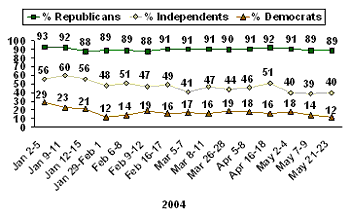If we've recognized no other trends over the past 10 or 12 years, the "Leona Helmsley-ing" of politics has become quite apparent to even the most casual observer. In the comments section of another recent thread on ASZ, I lamented the mean spirited nature of the political landscape. No longer is the practice of politics the domain of clashing liberal and conservative ideologies -- it's become the modern day equivalent of the Hatfield and McCoy wars.
Many pundits have opined that the continuous downward trend in voter participation is directly attributable to the negative perception that many folks attach to the process. Now more than ever, I think politicians are generally viewed somewhere beneath internet viagra scammers on the "respect-o-meter".
For a long time, I've felt that the mean spirited nature of politics has winnowed down the number of participating voters to pretty much the hardcore believers. Now, comes a poll and story from the Gallup Organization that validates my gut feelings:
PRINCETON, NJ -- An analysis of Gallup Poll data reveals extreme and unprecedented levels of polarization in George W. Bush's job approval ratings. Currently, Democrats and Republicans evaluate the president very differently, with Republicans overwhelmingly positive and Democrats decidedly negative. Views among both groups are quite strong, which means they are probably unlikely to change much between now and the election. Never before has Gallup data shown such a high proportion of partisans with such strongly opposing views of a president.(You might want to click through and read the whole story; there’s a lot there to digest.)
...The impressiveness of this gap is underscored by looking at historical approval ratings for other presidents who were similarly gearing up for a re-election bid. Aside from Bush, Bill Clinton had the largest partisan gap in approval ratings at a comparable point in his presidency, but his 60-point gap from May 1996 is nearly 25% smaller than Bush's. Ronald Reagan is the only other president to have a partisan gap in excess of 50 percentage points in May of his re-election year.
Bush's 70+-point gap is not only unprecedented for May of a re-election year, but it is unprecedented for any point in a re-election year. No president, dating back to Harry Truman, has had a partisan gap above 70 points in any Gallup Poll in a re-election year.
All of this begs the question - why is there such a gap? Perhaps the answer is, "because that's what they want". The partisan gap is a lead pipe lock guarantee for both parties. Both the Democratic Party and Republicans can count on the vote of their hardcore supporters. The soft "middle" shrinks, providing more predictability to the probable end result, and the ability to focus efforts primarily on swing states.
But I think the poll says something a bit different. My guess is that the gap on the Republican side has been there through several election cycles, because that's how the GOP has played their flock since the days of (at least) Reagan. The Democratic Party has only recently learned the power of the politics of division, and started to play by the rulebook invented by the GOP.
So what does this say for the campaign leading up to November? A newly energized Democratic Party base finally shows some teeth. That was quite clear in Al Gore's recent speech that's received so much play. It was even more clear last week in conservative pundit reaction to George Soro's speech at the Take Back America Conference in Washington. It's clear in the successful launching of Air America.
And that's as good of an explanation as The Gallup Organization needs in analyzing reasons for such an unprecedented perception gap. The GOP wants division? The Democratic Party is showing the GOP that two can play that game of chicken.
The only remaining issue: who blinks first?
